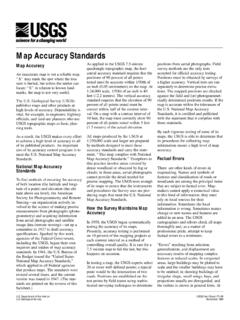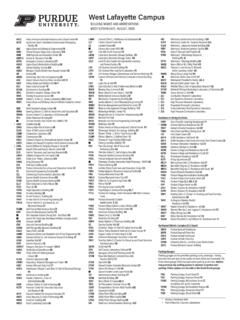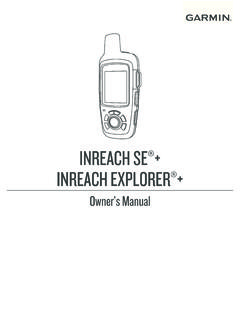Transcription of Chapter 2 Reading Topographic Maps and Making Calculations
1 Chapter 2 Reading Topographic Mapsand Making Calculations_____In this Chapter you will learn about: Reading the margins Interpreting contour lines Estimating slope Estimating aspect Estimating acreage Estimating distances Estimating percent containedA nice reference to have while Reading this Chapter is a USGS color Topographic Topographic map is printed on a flat piece of paper yet it provides a picture of the terrain and man-made features through the use of contour lines, colors and symbols. Contour lines represent the shapeand elevation of the land, such as ridges, valleys, and hills. Colors and symbols are used to representother features on the land, such as water, vegetation, roads, boundaries, urban areas and USGS produces a series of Topographic maps that are extremely accurate.
2 The United States wassystematically divided into precise quadrangles based on latitude and longitude lines and these maps arecommonly referred to as quads. This Chapter starts with tips on how to read the margins of a Topographic map. Then it describes how tointerpret contour lines. Finally, it covers how to estimate slope, aspect, acreage, distances, and percentcontained using a Topographic Land NavigationPage the MarginsThis section addresses how to read the information that is in the margins of a USGS Topographic starts with the upper left corner of the map and moves clockwise around the or Author Who Created Map (upper left corner of map)In Figure 2-1, the United States Department of the Interior Geological Survey is the agency that createdthe map. This same information can also be found in the bottom left 2-1.
3 Agency or author who created Land Navigation_____Page Title (upper right corner of map)This corner section provides the name of quadrangle, state (and sometimes the county) where thequadrangle is located, and map series. quadrangles are often named after a prominent town or featurethat is in the quadrangle. In Figure 2-2, the name of the quadrangle is Lucky Peak which is located inIdaho. The map series indicates how much land area is on the map; for example, in Figure 2-2 theLucky Peak quadrangle is a minute series which indicates it covers a four sided area of minutesof latitude and minutes of 2-2. Map Land NavigationPage Classification (bottom right corner of map)Road and trail symbols may be found in this legend (Figure 2-3).Revision Date (bottom right corner of map)Some maps have a revision date, which is when the map was last updated.
4 If the map is old, it may notbe accurate. In Figure 2-3 the revision date is 1972. Refer to the Map Production Information blockin the bottom left corner for additional information on map Location (bottom right corner of map)The location of the quadrangle is pinpointed on a map of the state (Figure 2-3).Adjoining Quadrangle Legend (corners of map)Names of adjoining quadrangles are frequently indicated in the corner margins of USGS topographicalmaps; Mayfield is the joining quadrangle in Figure 2-3. Road classification, revision date, quadrangle locationand adjoining Land Navigation_____Page Topographic maps will have an adjoining quadrangle legend (Figure 2-4).Map Scale (bottom center of map)The map scale indicates the ratio or proportion of the horizontal distance on the map to thecorresponding horizontal distance on the ground (Figure 2-5).
5 Figure 2-4. Example of an adjoining quadrangle 2-5. Map scale (fractional scale and bar scale) and contour Land NavigationPage are two types of scales on the Topographic map: Fractional ScaleThe fractional scale expresses the ratio of the map distance to the ground distance in like units ofmeasurements. It is usually written as a fraction or ratio. For example, the map in Figure 2-5 has amap scale of 1:24,000 which means one inch on the map is 24,000 inches on the , USGS produces maps using the 1:24,000 scale, but will also produce maps using1:62,500 and 1:250,000 scale. The 1:24,000 scale provides larger and clearer details than the1:250,000, but it does not cover as large an maps produced at a 1:24,000 scale (1 inch represents 24,000 inches or 2000 feet) arecommonly known as quadrangle maps; each map covers minutes of latitude minutes of longitude, which is approximately 8 miles (north/south) and 6 miles (east/west).
6 The primary scale used in Alaska Topographic maps is 1:63,360 (1 inch represents 1 mile) due tothe size of the state. The Alaska quadrangle map covers 15 minutes of latitude and varies from20 36 minutes of longitude. Bar or Graphic ScaleA graphic scale or comparison scale is entirely different from the representative fraction usually compares map distances to the ground distance in different units of a graphic scale is a line marked off on a map indicating so many inches or millimeters equalto so many feet, kilometers, chains, or miles on the ground. A comparison scale of 1 inch to 2000feet means that 1 inch on the map is proportioned to 2000 feet on the ground. We are comparinginches and feet which are different units of Interval (bottom center of the map)Contour interval is the difference in elevation between two adjacent contour lines.
7 In Figure 2-5, thecontour interval is 40 feet. On USGS maps, contour intervals are usually 1, 5, 10, 20, 40, and 80 the contour interval is not printed on the map, it can be calculated (which is discussed later in thischapter).Basic Land Navigation_____Page Arrow, Declination, and Map Production Information (bottom left corner ofmap)It is common practice for maps to be oriented with true north at the top. Most USGS maps have asymbol of arrows pointing to the geographic North Pole (shown by a star), magnetic north (MN) andgrid north (GN). Grid north shows the difference between geographic north (latitude/longitude) and theUTM Figure 2-6, the magnetic north is degrees east. The difference between the geographic NorthPole and magnetic north is the magnetic declination for that 2-6.
8 North arrow and magnetic Land NavigationPage the declination is not indicated on the arrow diagram, it can be found in the Map ProductionInformation which is in the lower left corner of the map (Figure 2-7). The map production informationsection provides additional information on how and when the map was created. Sometimes themagnetic declination is printed and UTM ZoneThe datum and UTM zone, which are extremely important when using a GPS receiver, can also befound in this block (Figure 2-7). Vertical and horizontal datums may be listed on the map; however, ifthe map lists only one datum then the vertical and the horizontal datum are the 2-7. Map production information block often includes revision dates,datum, and UTM Land Navigation_____Page and Longitude (edges of map)Latitude and longitude lines are indicated with fine black tick marks along the edges of the map(Figure 2-8).
9 Topographic maps do not show the latitude/longitude lines just the tick numbers next to the tick marks indicate degrees ( ), minutes (') and seconds (").On 1:24,000 scale maps, latitude and longitude tick marks are indicated every minutes. Longitude tick marks are on the top and bottom edges of the map and latitude tick marks areon the right and left edges. Note that the degrees may be left off (as an abbreviation) and youmay only see the minute and/or second designations. Reference coordinates for latitude and longitude (degrees, minutes, and seconds) are black andlocated on the four corners of the map. The intersection of latitude and longitude lines are noted by cross-marks (+).When Reading latitude/longitude, pay close attention to the units (degrees, minutes, seconds) because itis easy to misread them.
10 Refer to Chapters 3 and 6 for additional information on latitude and tick marks (50'),latitude tick marks (35'),reference coordinates(118 52' 30" and 37 37' 30"),and cross-mark (+) in bottomright Land NavigationPage Transverse Mercator (UTM) (edges of map)Prior to 1978, USGS Topographic maps used blue tick marks along the edge of the map to illustratewhere the UTM grid lines were located. Since 1978, USGS Topographic maps actually show UTMgrid lines (black) on the map and the coordinate values are in the margin. On USGS Topographic maps, quadrangle, the UTM grid lines are marked at 1,000 meter increments (Figure 2-9). Abbreviated easting values, for example 336, are located on the top and bottom edges of the map. Abbreviated northing values, for example 4164, are located on the right and left edges of the map.




